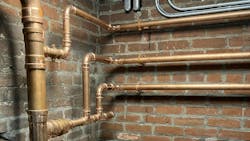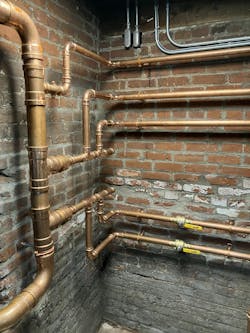Gorgeous Hydronic Piping – But Beware the Butterfly Effect
Key Highlights
- Proper primary/secondary piping connections are crucial for system efficiency and avoiding flow issues
- Troubleshooting air entrapment can involve adding manual vents
- Hands-on experience is vital for mastering boiler system design, troubleshooting, and optimization
What beautiful piping! That was my initial reaction when I walked into the boiler room. I’ve always loved the color of copper, and that’s big stuff. The larger piping is 3” while the smaller pipes are 1-1/2”. It’s like a metal sculpture you would see hanging on an exposed brick wall in a trendy art gallery.
To the Right and the Left
What you don’t see to the right are two 500,000 btuh mod-con boilers with touch screen controls. The programing is now done by sliding bars and saving changes. I’m not completely sold on the idea yet, but the more I work with it, the more favorable my opinion.
We started years ago with interpreting the code on the screen, then we got actual words that described actual parameters that we could adjust to match the application. Now, we have it all literally at our fingertips. What next, flying cars?
So the flow from the system is coming from right and left to combine into the vertical 3” pipe, flowing down, or from the ceiling to the floor. The next two full size tees are part of the primary/secondary connection, allowing the system loop (primary) and boiler loop (secondary) to have flow rates that don’t affect each other.
I was taught many years ago that the main loop was the primary and the branch loop was the secondary. Made sense to me, but most boiler manufacturers changed that around when they introduced the concept with mod-cons.
Nowadays, I say system loop and boiler loop when referring to primary/secondary piping, low loss headers, or hydraulic separators. All three piping techniques have four connections: boiler supply, boiler return, system supply and system return.
The Kid is Growing Up
I was teaching a class the other night, the Kid was there. You remember the Kid, the guy I was training years ago. Well he interrupted me while I was explaining primary/secondary piping to the class. Maybe I was between points, but it definitely surprised me because he’s usually pretty quiet.
He went up to the whiteboard and drew a primary/secondary connection done wrong, on purpose. He had it configured like many installers have tried over the years, with the branch connections of the tees piped together. It makes a nice square on paper, but isn’t the way it’s supposed to be.
He explained that the correct way is with the common connection between the tees to be on the run of the tees, not the branches. He then drew a primary/secondary connection for a mod-con boiler the right way. A tear came to my eye; the Kid is growing up.
Less Than Perfect
This job was piped correctly, primary/secondary connections can be in a horizontal or vertical orientation. The tees are close enough and full size. Then there is a reduction from 3” to 1-1/2” on the boiler loop, which isn’t exactly correct, but he called one day to say his fitting supplier couldn’t furnish the right stuff and could he do it like that.
Sometimes I allow less than perfect/correct piping because the difference doesn’t have much effect on performance. In this case, the smaller than ideal pipe size creates more water pressure drop in the common boiler loop piping, when both boilers are running. This increase is easily handled by the boiler loop pumps, which have extra capacity. They might run on the high speed instead of the medium speed.
The installer took great care to make the connections on the boiler loops the same distance, what I call the butterfly look, since butterfly wings are generally identical. In this case, with the piping running horizontally, he branched the return piping up while branching the supply piping down.
It looks great, but creates an effect—a butterfly effect. Since it goes up higher than the return connection on the boiler, it has to go back down. Whenever a horizontal pipe goes up vertically and goes back down vertically, air can get trapped at the high point. When enough air gets trapped, circulation stops.
Troubleshooting
That is exactly what happened when we started up the boilers. The burners came on, the water in the heat exchanger got super-hot and the boiler went into a hard lockout. I had them check the wiring for the boiler loop pump, since this is an indication that we didn’t have water flow through the boiler and found out that they were wired incorrectly.
With this boiler manufacturer, the boiler loop pump is wired differently depending if it is a commercial or residential boiler. He must have had his residential thinking cap on when he wired it. After it was re-wired, it did the same thing. It was the air in the return line.
We were able to purge the air out by closing the valves on the boiler supply lines and opening the boiler drains, one boiler at a time. It worked a couple of times but reappeared a couple of times before we decided to go to lunch. Air was coming back from the system and getting trapped in those high points on the boiler return lines.
At lunch, it was decided to add manual vents to those high points to bleed the air out, after leaving the system pumps on for the weekend to get more air out through the in-line air separator.
This is the seventy second column I’ve written for CONTRACTOR. When they called me six years ago, I said I would try to do this for three years. I sometimes think that I will run out of informative topics, but then one of the next site visits has that photo op that I can ramble on about.
About the Author
Patrick Linhardt
Patrick Linhardt is a forty-one-year veteran of the wholesale side of the hydronic industry who has been designing and troubleshooting steam and hot water heating systems, pumps and controls on an almost daily basis. An educator and author, he is currently Hydronic Manager at the Corken Steel Products Co.

